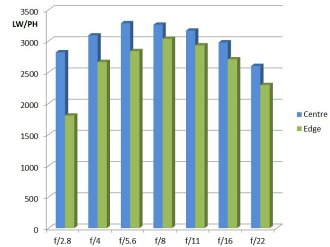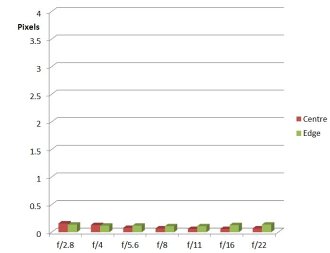Zeiss Milvus 21mm f/2.8 Lens Review
Zeiss Milvus 21mm f/2.8 Performance
It is clear from the start that we have here a high performing lens. Although it is possible to induce flare, for example, it needs very extreme circumstances to do so. For most realistic purposes though the lens is flare free. Likewise chromatic aberration, which is as close to zero as we could hope for. Colour fringing will not be a problem even in the most demanding situations.
Sharpness is also of a very high order. At the centre, the image sharpness is excellent from the outset. It only drops to a level that could be described at very good when we reach the minimum aperture of f/22. Central performance peaks at f/5.6, but the variation is very small indeed.
The edges do lag behind slightly, with open aperture being good, reaching a very good level at f/4 and peaking at excellent levels between f/5.6 and f/11. Edge sharpness is still very good through to f/22.
This really is uniformly excellent and very welcome in a lens that will likely be used at smaller apertures for landscapes where we might want to maximise depth of field.
How to read our charts
The blue column represents readings from the centre of the picture frame at the various apertures and the green is from the edges.The scale on the left side is an indication of actual image resolution as LW/PH and is described in detail above. The taller the column, the better the lens performance.
For this review, the lens was tested on a Nikon D600 using Imatest.
Distortion measures the ability of a lens to render straight lines accurately. With lenses as wide as 21mm this is often allowed to drift a little, but the Milvus only shows a very modest -0.954% of barrel distortion. This is unlikely to be much of an issue, but for the most critical applications it can also be tackled in software. We see 24mm lenses with much higher distortion figures than this.
How to read our charts
Chromatic aberration is the lens' inability to focus on the sensor or film all colours of visible light at the same point. Severe chromatic aberration gives a noticeable fringing or a halo effect around sharp edges within the picture. It can be cured in software.Apochromatic lenses have special lens elements (aspheric, extra-low dispersion etc) to minimize the problem, hence they usually cost more.
For this review, the lens was tested on a Nikon D600 using Imatest.
Bokeh, the rendition of the out of focus areas in an image, is a major consideration for many photographers. The Milvus 21mm renders such areas very well, with smooth rendition of even quite busy detail. There is a smoothness, a fluidity, and the end result is pictorially very satisfactory.
Value For Money
The Zeiss Milvus 21mm f/2.8 lens is priced at £1299, not a small amount but much more realistic than the high end Otus lenses. Zeiss themselves offer an alternative in the 21mm f/2.8 T* Distagon at £1449.
Nikon has the 20mm f/1.8 G AF-S at £579. Canon's offering is the EF 20mm f/2.8 USM, priced at £385. The Sigma alternative is the 20mm f/1.4 DG HSM Art lens at £629.
The alternatives are AF lenses, but the Zeiss are MF only, so can the much higher price be justified? This is a particularly personal choice that needs to be made, but if we accept there is value in high end performance, quality of manufacture and the simple joy of using finely made items, then the normal concepts of value for money may not hold. I would suggest that for what it offers, the Zeiss Milvus 21mm f/2.8 is good value.
For more options have a look at the Top 15 Wide-angle Lenses.
Add your message
Please login here or if you've not registered, you can register here. Registering is safe, quick and free.
photodo Stats
428 MTF tests
74 in-depth photodo reviews
100+ users join each day
Help the lens community by reviewing or rating a lens today via our lens search
Latest Lens Reviews
- Chinon 28mm f/2.8 Vintage Lens Review
- Canon EF 70-200mm f/4L IS II USM Lens Review
- Samyang AF 85mm f/1.4 EF Review
- Sigma 70mm f/2.8 DG Macro Art Review
- Samyang AF 24mm f/2.8 FE Review
- Meike 50mm f/1.7 Review
- Tamron 70-210mm f/4 Di VC USD Review
- Lensbaby Burnside 35mm f/2.8 Review
- Asahi Super Takumar 50mm f/1.4 Review
- Asahi Super-Multi-Coated Takumar 135mm f/3.5 Review


